News Articles
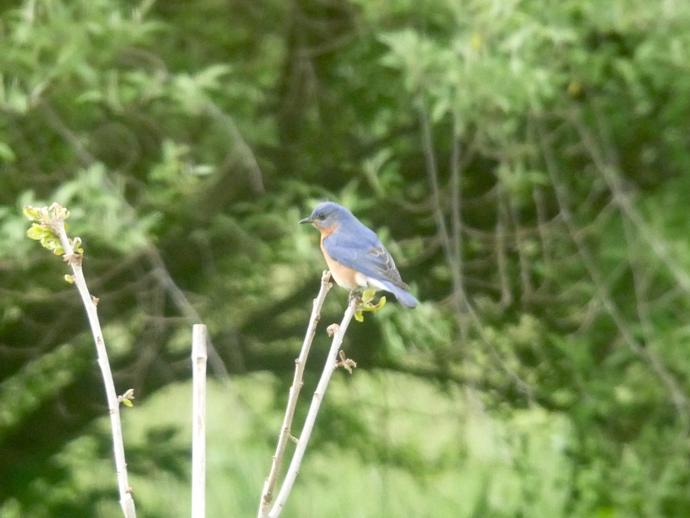
The eastern bluebird (Sialia sialis) ...
April 30, 2020
The eastern bluebird (Sialia sialis), seen here perched on my newly-planted persimmon tree, is one of the great comeback stories of the conservation movement. In the middle of the 20th century, vast amounts of farmland that bluebirds used to call home had been converted into housing and industry, and heavy pesticide use had put the bluebird at even more risk since insects make up a large portion of their diet. To make matters worse, European house sparrows (Passer domesticus) had been introduced to the U.S. in the 1800s in the hope that they would eat crop pests. As with most introduced species, they instead ended up outcompeting native species. Like bluebirds, house sparrows also prefer to build their nests inside hollow ...
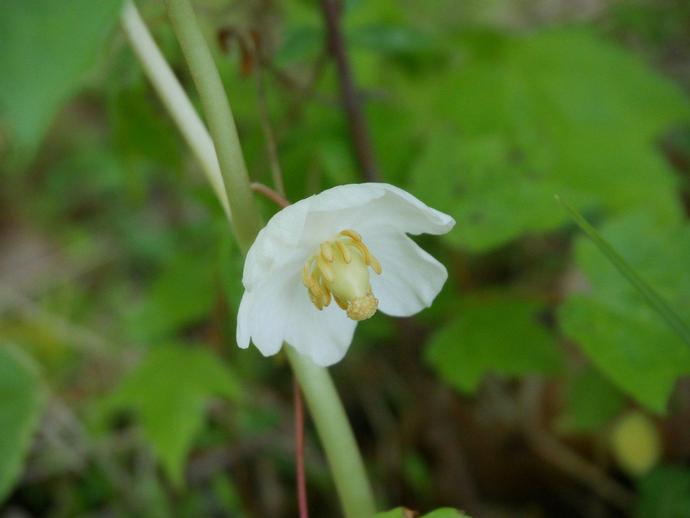
The mayapple (Podophyllum peltatum) ...
April 29, 2020
The mayapple (Podophyllum peltatum), also known as American mandrake and ground lemon, is fairly widespread across the eastern U.S. and southeast Canada. These plants can grow about a foot tall and produce umbrella-like leaves. In the spring, they produce white or yellow flowers (I've also read they can produce red flowers, although I've never seen one myself). By the summer, these flowers turn into a fleshy fruit that can be either green, yellow, or red -- it's like nature's traffic light! From what I've read, all parts of the plant are toxic, although the fruit can be eaten "in small amounts" if the seeds are removed. Since we all have different definitions of "a small amount" (for example, I consider a pint of ice cream ...

Dear VMNH community ...
April 29, 2020
Dear VMNH community, As you know, we remain closed to the public and are allowing minimal staff to enter and use the museum's facilities. However, we are in a constant state of preparing to re-open. It will happen eventually, and your desire to engage the science of the natural world will be fulfilled! We are looking at data from the Virginia Department of Health to inform our decisions to bring staff back to operate the museum properly, and also when we'll open publicly. It is, of course, too early to give a specific timeline, but we are keeping a close eye on the data and receive many updates from Richmond. When re-opened, staff will undergo new sanitation procedures and we have some ideas on how to enhance the visitor ...
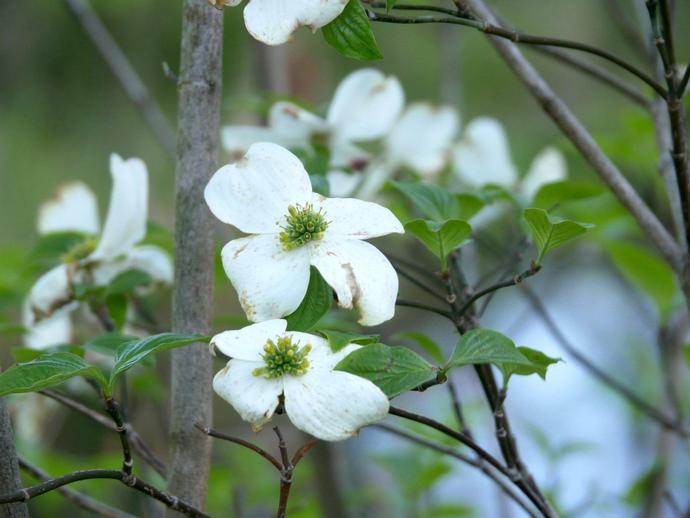
This tree should certainly be a familiar sight to Virginia residents!
April 28, 2020
This tree should certainly be a familiar sight to Virginia residents! The flowering dogwood (Cornus florida) is both the state tree and the state flower of Virginia. Speaking on a strictly technical level, however, the dogwood's flower isn't what we generally think it is. The four white petals aren't petals at all; they're structures called "bracts," which are modified leaves that surround the actual flowers. The flowers themselves are the tiny greenish-yellow things in the center of the bracts. Another example of this is the poinsettia plant; the bright red "flowers" of the poinsettia are bracts as well. So the next time someone comments on the beautiful white flowers of your dogwood tree, you too can pedantically correct ...
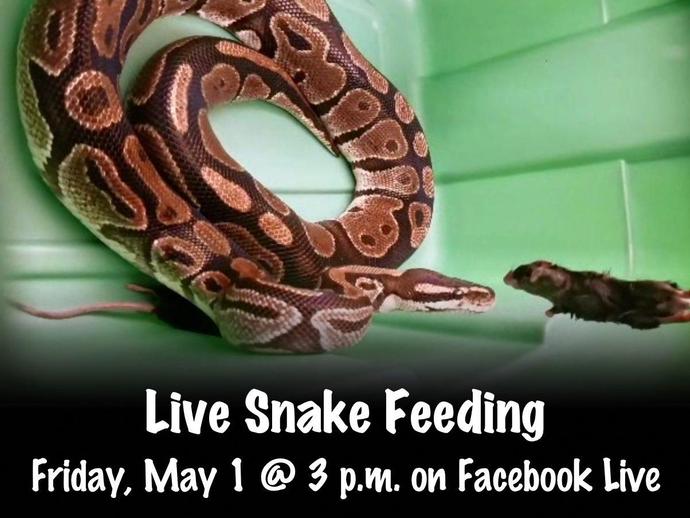
This Friday is feeding day for the museum's resident snakes!
April 28, 2020
This Friday is feeding day for the museum's resident snakes! Museum Educator Kayla Lacy will take to Facebook Live on May 1 at 3 p.m. to feed the museum's corn snake and ball python. PLEASE NOTE: The snakes are fed deceased mice. Some viewers may not wish to watch this feeding.
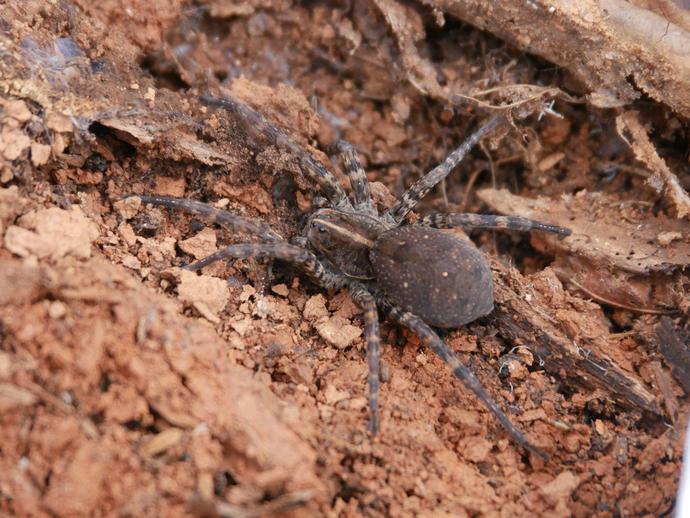
I realize that a lot of folks don't like spiders ...
April 27, 2020
I realize that a lot of folks don't like spiders, especially enormous spiders presented in close-up photos that highlight every fuzzy leg and beady eye. But like them or not, spiders are fascinating creatures and are well worth examining! According to VMNH Associate Curator of Invertebrate Zoology Dr. Kal Ivanov, this is likely a female Tigrosa georgicola, which is a commonly encountered wolf spider here in Virginia. Wolf spiders are some of the largest spiders you can find in the Commonwealth, rivalled only by Dolomedes tenebrosus, the dark fishing spider, and Argiope aurantia, the black and yellow garden spider. This particular wolf spider was certainly one of the largest I've ever seen. Wolf spiders are generally ...
Dr
April 27, 2020
Dr. Adam Pritchard, assistant curator of paleontology, may be hunkered down at home for the time being, but he's still determined to bring the wonders and knowledge of paleontology to VMNH audiences through his informative and fun video series titled "Tales of Ancient Life"! In this episode of "Tales of Ancient Life", Dr. Pritchard discusses an intriguing animal from the Triassic period - a time between 252 million and 200 million years ago - that is noted as the beginning of the age of reptiles. For young scientists watching, be sure to watch until the end, as Dr. Pritchard has a couple of science assignments you can complete at home related to the information shared in this latest episode of "Tales of Ancient Life"!
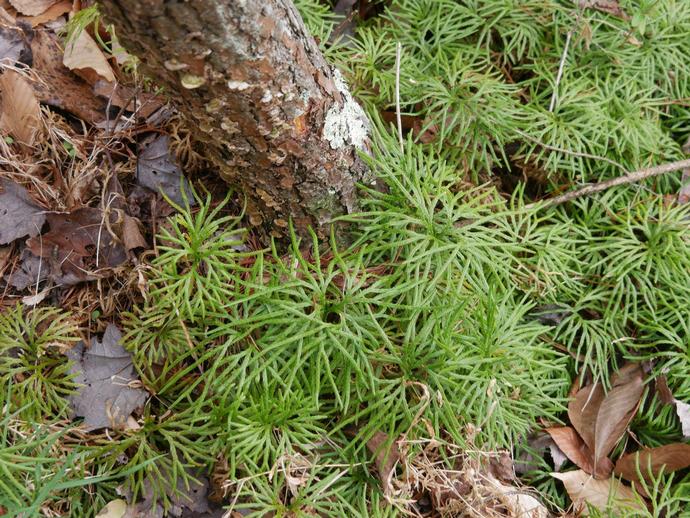
You've probably seen this plant before, carpeting the forest floor like some sort of
April 26, 2020
You've probably seen this plant before, carpeting the forest floor like some sort of ... carpet. This is Diphasiastrum digitatum, also known as ground cedar or fan clubmoss. Clubmosses like this one are lycopods, which is the oldest surviving division of vascular plants. The earliest lycopod fossils date back more than 400 million years! While the surviving members of the division are all pretty small, ancient lycopods from hundreds of millions of years ago resembled towering trees. If you've ever attended Dragon Festival at the Virginia Museum of Natural History, you're probably familiar with these unique plants. The museum's partners in the Dragon Research Collaborative at Roanoke College theorize that dragon myths ...
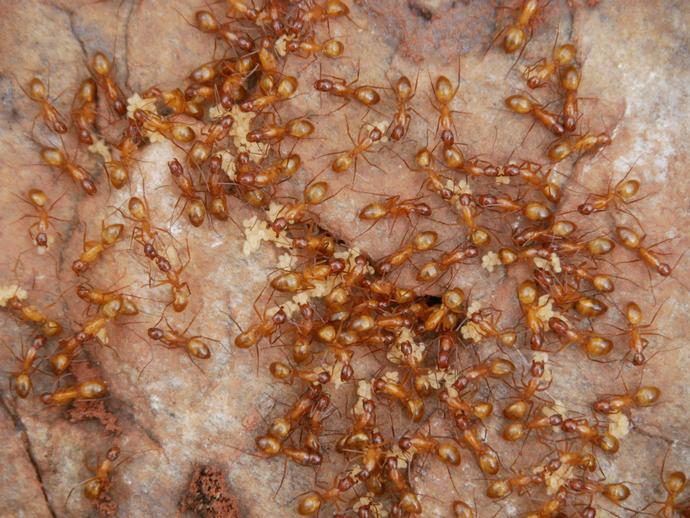
I figured I should do a post about ants before our Associate Curator of Entomology Dr
April 25, 2020
I figured I should do a post about ants before our Associate Curator of Entomology Dr. Kal Ivanov stops speaking to me! Dr. Ivanov recently published a paper listing the known ant species of Virginia, and he knows more about ants than ants know about themselves. As such, he quickly identified these guys as Camponotus castaneus, a species of carpenter ant that is widely distributed throughout the eastern U.S. Carpenter ants get their name because they build their nests in dead wood, chewing out elaborate galleries with their mandibles. While termites eat wood, carpenter ants do not; they generally forage at night for dead insects to eat. Many species of carpenter ant also tend aphids, offering them some extra protection in ...
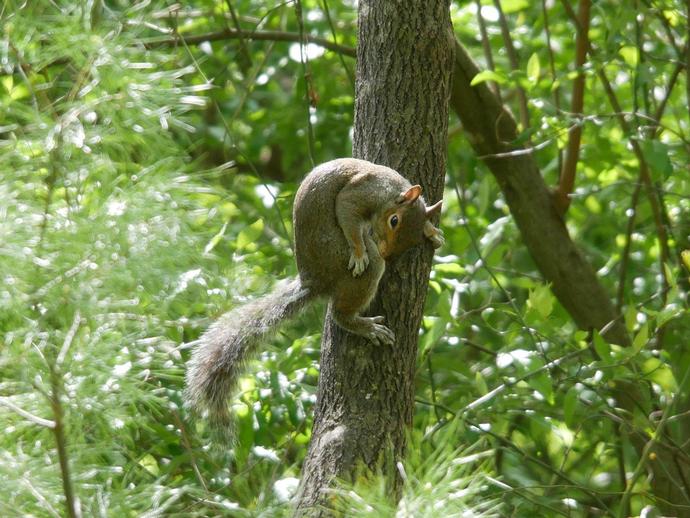
Most of the time ...
April 24, 2020
Most of the time, animals seem to have an uncanny ability to tell when a camera is in focus and pointed at them, at which point they spring away and disappear. Every once in a while, though, you get lucky and a squirrel strikes a cool pose right in front of you (by the way, please direct all photography awards and corresponding massive cash prizes to Ben Williams c/o The Virginia Museum of Natural History). At any rate, Sciurus carolinensis, better known as the eastern gray squirrel, is a pretty common sight in southwest Virginia. If you have bird feeders, it may be too common of a sight. However you feel about them, though, squirrels are remarkable animals. We've all seen squirrels burying nuts and seeds for later ...
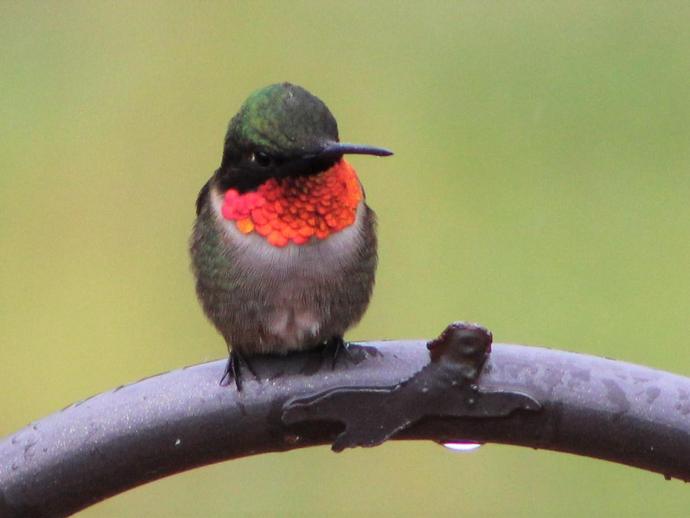
Named for the red ...
April 23, 2020
Named for the red, iridescent throat feathers of the adult male, the Ruby-throated hummingbird is Virginia's only resident hummingbird. In some lights, and at certain angles, the throat of the adult male can appear black. These photos were captured by VMNH Associate Curator of Recent Invertebrates Dr. Kal Ivanov. Even Dr. Ivanov needs a break from studying insects every once in a while!
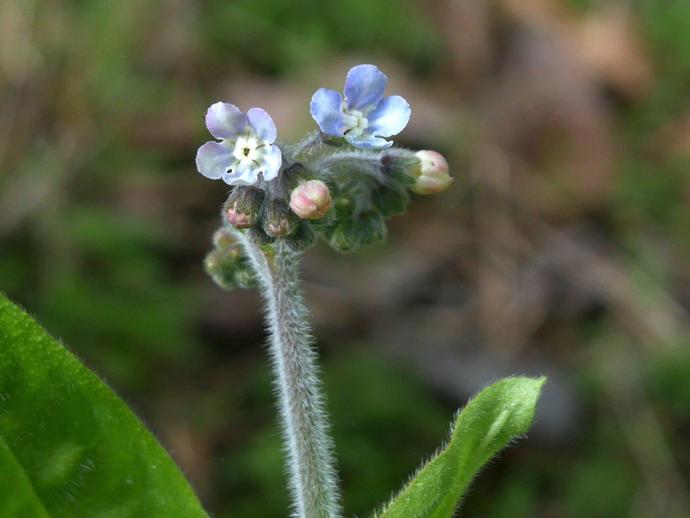
The small blue flowers of Cynoglossum virginianum (commonly known as "wild comfrey") are easy to ...
April 23, 2020
The small blue flowers of Cynoglossum virginianum (commonly known as "wild comfrey") are easy to miss, since they're often pretty tiny in comparison to the rest of the plant. The Greek name "Cynoglossum" roughly translates to "dog's tongue," and the plant is sometimes called "blue houndstongue." This is because the size and shape of the leaves bear a striking resemblance to -- you guessed it -- a dog's tongue! This wild plant is native to the eastern U.S. and much of Canada, and it thrives in habitats with high humidity, low temperatures and low competition. For these reasons, forests are a good place to spot this plant. It's believed that Cynoglossum virginianum is adapted to thrive following occasional forest fires, as ...
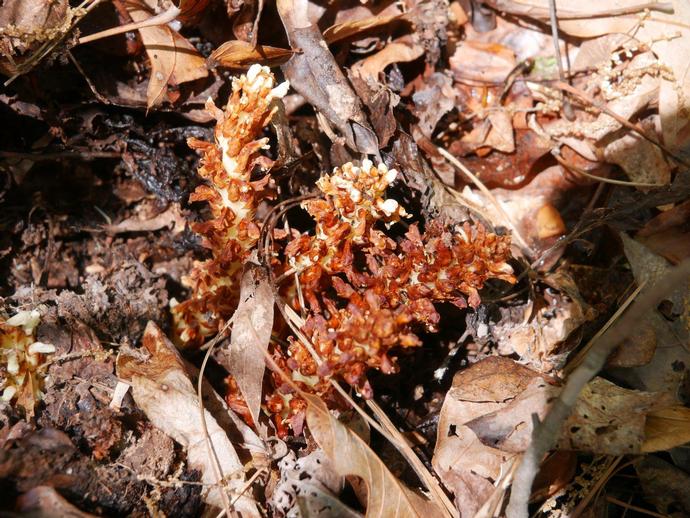
As little kids ...
April 22, 2020
As little kids, we're taught that plants have a green pigment called chlorophyll that absorbs sunlight and converts it into energy. While that's true for most plants, there are actually about 3,000 plants around the world that don't rely on the sun to get their energy. One of several examples that you can find in the woods here in southwest Virginia is Conopholis americana, also known as cancer root, squaw root, or bear corn. This plant doesn't have chlorophyll; instead, it's a parasitic plant that attaches to the roots of oak trees and beech trees, producing small suckers that leech nourishment from the host tree. Since this plant doesn't photosynthesize, it has no need for leaves. In the spring, it produces spikes of ...
The Virginia Beach bug (Pycnoderiella virginiana) hasn't been seen in three decades
April 22, 2020
The Virginia Beach bug (Pycnoderiella virginiana) hasn't been seen in three decades. Is it one of our state's rarest native insects? Or is it neither rare ... nor a true Virginian? Click to find out! About this article: Since 2016, VMNH has partnered with the Richmond Times-Dispatch to provide insights into the fascinating flora and fauna of Virginia. This article highlighting the Virginia Beach bug is the latest in the series.
Happy Earth Day to all of our friends and supporters!
April 22, 2020
Happy Earth Day to all of our friends and supporters!! Earth Day turns 50 today and our friends at EarthDay.org are celebrating the occasion by flooding the world with live messages of hope, optimism and, above all — action! We encourage you to check-it out!
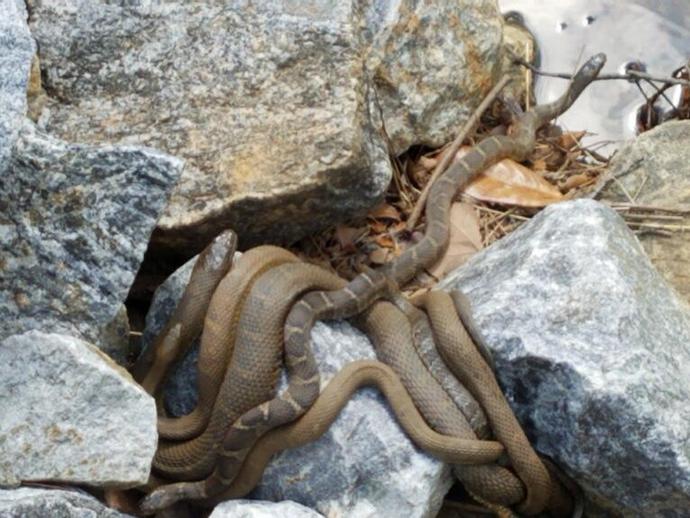
So, how many snakes do you see? Associate Curator of Recent Invertebrates Dr
April 21, 2020
So, how many snakes do you see? Associate Curator of Recent Invertebrates Dr. Kal Ivanov captured this picture of Northern water snakes (Nerodia sipedon) basking at Lake Lanier in Martinsville.
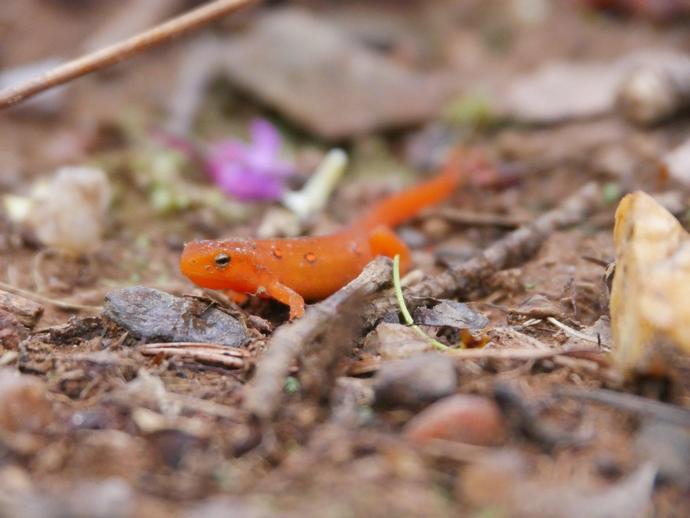
The eastern newt Notophthalmus viridescens is fairly common, but its life cycle is anything but
April 21, 2020
The eastern newt Notophthalmus viridescens is fairly common, but its life cycle is anything but. These newts start their lives as brownish-green aquatic larvae with gills. After about three months, they turn bright reddish-orange, emerge onto land, and shed their gills. During this terrestrial stage of life, they are known as "red efts" (the two pictured eastern newts are both red efts). During this time, red efts will wander as far as their tiny legs can carry them as they seek out a new pond to call home. After two or three years, when the eft finds a new pond, its bright colors begin to fade back to a dull olive. It grows a wide, paddle-like tail, slips into its new pond, and becomes an aquatic adult. So why the bright ...
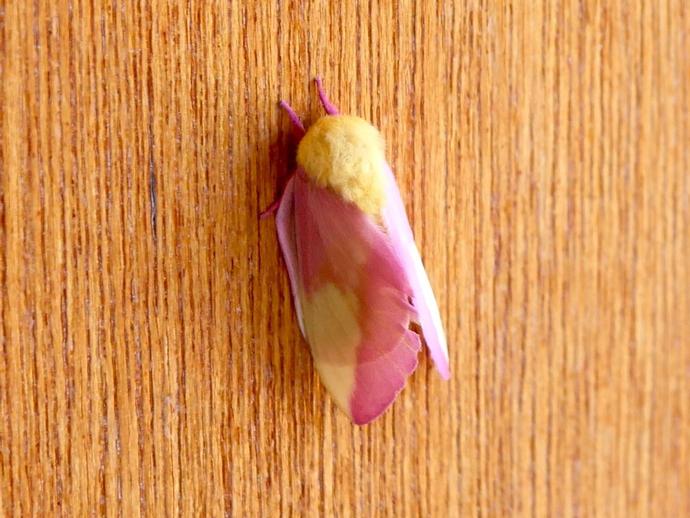
Everyone loves butterflies, but moths often don't get the respect they deserve
April 20, 2020
Everyone loves butterflies, but moths often don't get the respect they deserve. Sure, a lot of moths are kind of drab, but there are plenty of beautiful moths out there, too. Case in point: Dryocampa rubicunda, also known as the rosy maple moth. This moth belongs to the family Saturniidae -- the great silk moths -- which includes some of the largest moths in the world. The rosy maple moth definitely isn't a giant, but its fuzzy pastel coloration makes it a striking sight nonetheless. As the common name suggests, the caterpillars of these moths prefer to feed on the leaves of maple trees. While they can cause aesthetic damage, they won't kill your maple tree. Once the caterpillars turn into moths, they won't damage your ...
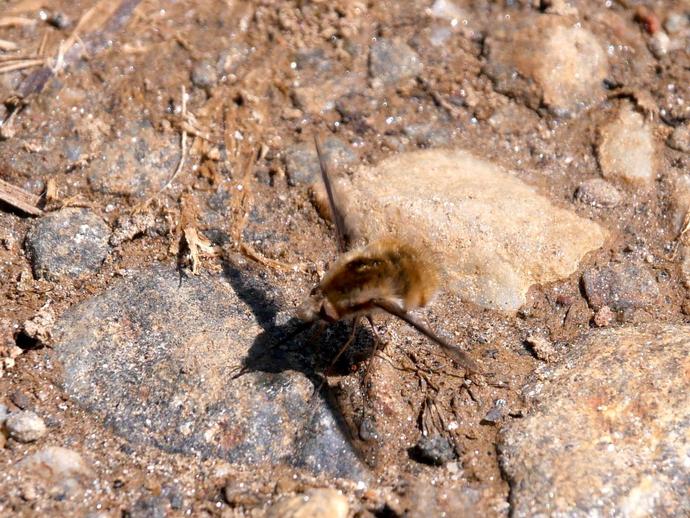
With its cute fuzzy abdomen ...
April 19, 2020
With its cute fuzzy abdomen, you could easily mistake this fellow for a friendly bumblebee; however, it's all a clever ruse! This is Bombylius major, also known as the large bee fly, and as the name suggests, it's actually a fly in disguise. An easy way to tell that they're flies instead of bees is that they only have one pair of wings as opposed to two. Bee flies don't bite, sting, or spread disease, and they're important generalist pollinators. In addition to being found in North America, this species can also be found in Europe and parts of Asia. Bee flies have likely evolved to resemble bumblebees for a couple of reasons. First off, their appearance likely deters predators that would enjoy eating a fly but wouldn't mess ...
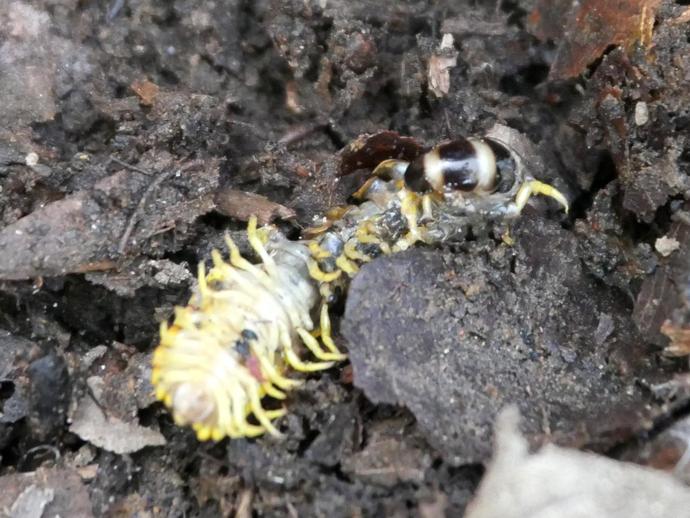
Today's nature update is something pretty cool (and gross!) that you don't see every day
April 18, 2020
Today's nature update is something pretty cool (and gross!) that you don't see every day. It's also a two-for-one. Here we see two different insects: the yellow thing is a millipede that is having a sincerely bad day, and the shiny black thing that's where the millipede's head should be is a Phengodes larva. Phengodes is an extremely interesting genus of beetles. They belong to the beetle family Phengogidae, which are known as the "glow-worm beetles." The beetle larvae are bioluminescent, meaning that they glow in the dark! Phengodes larvae and larviform females (the females of this family still resemble larvae even when mature) are predators, and they love to eat millipedes. So how do they do it? Well, you might want to ...
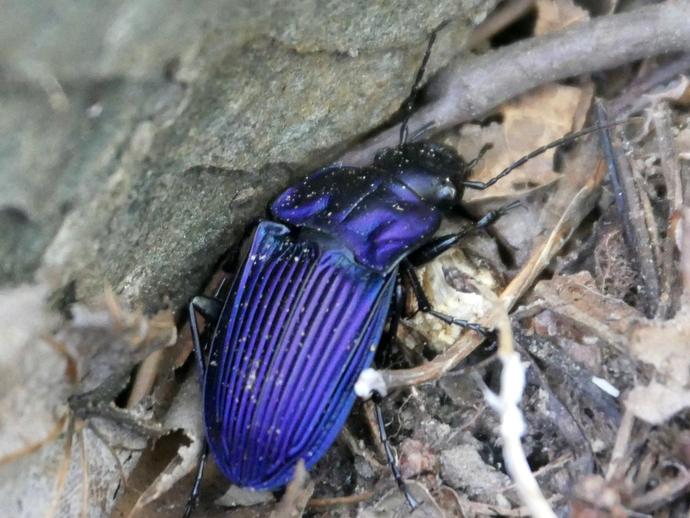
With its brilliant purple elytra (the shell that covers the flight wings) ...
April 17, 2020
With its brilliant purple elytra (the shell that covers the flight wings), this beetle almost looks like something you'd find in the tropics, but you can find them right out in the woods in southwest Virginia! According to Virginia Museum of Natural History Research Associate and Professional Beetle Expert Curt Harden, this fellow is Dicaelus purpuratus. It's active from the spring through the fall, and it likes to hide in leaf litter and under logs. These beetles are snail-eaters, and it's probably no coincidence that on the same day I found two of these beetles, I found a couple of empty snail shells not far away. #BenInNature About this post: Social distancing can be difficult, but the next few weeks present a great ...
Although museum staff are working from home for the time being ...
April 17, 2020
Although museum staff are working from home for the time being, the VMNH resident animals still need to be fed! Today, Museum Educator Kayla Lacy was at VMNH to feed the turtles and give audiences a virtual tour of the turtle habitat, while explaining the feeding process and giving some interesting tidbits about these animals.
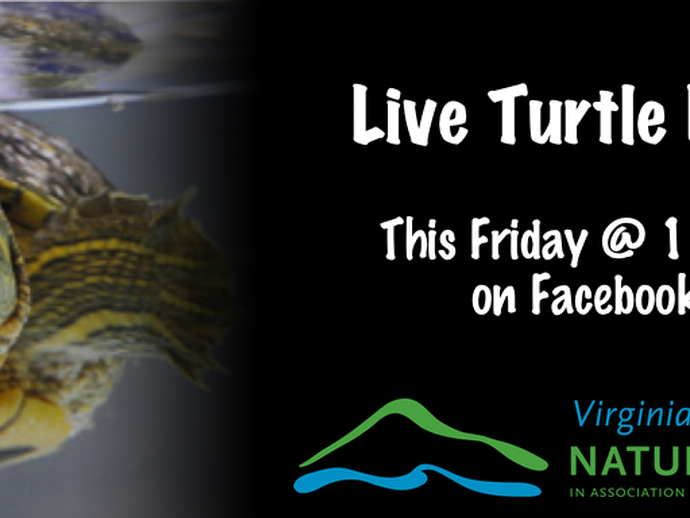
Tune in to the VMNH Facebook page tomorrow at 10:30 a
April 16, 2020
Tune in to the VMNH Facebook page tomorrow at 10:30 a.m., when Museum Educator Kayla Lacy feeds the museum's turtles!
Dr
April 16, 2020
Dr. Adam Pritchard, assistant curator of paleontology, may be hunkered down at home for the time being, but he's still determined to bring the wonders and knowledge of paleontology to VMNH audiences! In this episode of "Tales of Ancient Life", Dr. Pritchard explores the strange and amazing reptiles of the Triassic period. Be sure to watch until the end for a couple of activities that you can conduct with your young learners at home! After the video is over, be sure to learn more about Triassic reptile species by visiting www.activewild.com/triassic-animals/. #TalesofAncientLife
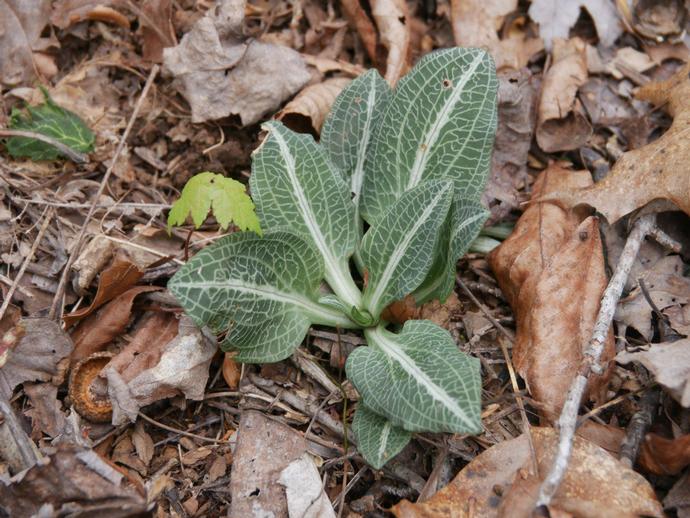
When we think of orchids ...
April 16, 2020
When we think of orchids, we usually think of rare, ornate flowers growing from a tree in a misty swamp somewhere. In fact, there are a number of species of orchids you can find out in the woods right here in southwest Virginia! For the most part, the orchids you'll find locally aren't nearly as showy as the orchids you would buy from a nursery (with the exception of Cypripedium acaule, better known as the pink lady's slipper, which I am on a mission to find). The pictured orchid is an excellent example of one of our more common, less showy orchids. This is Goodyera pubescens, commonly known as "rattlesnake plantain." The variegated leaves with their striking veins make rattlesnake plantain fairly easy to spot. This plant ...
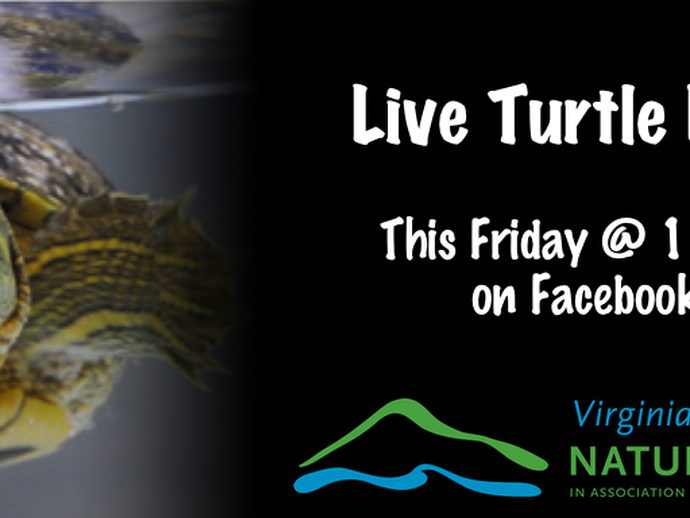
Museum staff are currently teleworking, but the museum's resident animals still need to be fed!
April 15, 2020
Museum staff are currently teleworking, but the museum's resident animals still need to be fed! Join Museum Educator Kayla Lacy live at 10:30 a.m. this Friday (4/17), when she feeds the museum's turtles!
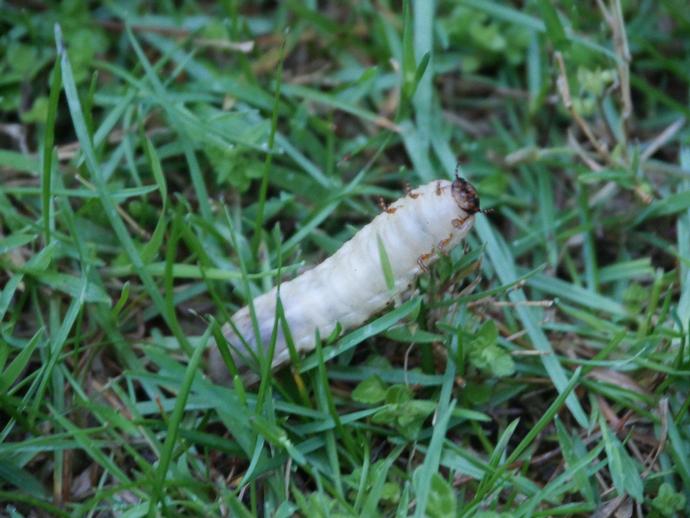
Immediately following the recent heavy storms ...
April 15, 2020
Immediately following the recent heavy storms, I was poking around in my yard and spotted this large beetle grub doing its best impression of Andy Dufresne after escaping from prison in "The Shawshank Redemption." Beetle grubs generally live in the topsoil where they eat the roots of plants. This poor fellow came topside so it wouldn't drown in the sodden earth. Because beetle larvae eat plant roots, they are generally considered a major lawn pest. If your yard has a large population of beetle grubs, you might even find yellow patches of grass that can be rolled back like a carpet. But which would you rather have, a pristine yard or a summer filled with awesome beetles to enjoy? I know which camp I'm in. #BenInNature About ...

If you missed last week's Super Pink Moon ...
April 15, 2020
If you missed last week's Super Pink Moon, don't worry; VMNH Educator and astronomy enthusiast Kayla Lacy photographed it for you. Below, Kayla explains exactly what a Super Pink Moon is: Did you see the Super Pink Moon on the night of April 7th? A super moon can appear much bigger than an average full moon! This happens when a full moon closely coincides with perigee, which is the closest that the moon comes to Earth in its elliptical orbit. On average, the moon is roughly 238,900 miles from Earth. During this super moon, it was around 221,772 miles away - over 17,000 miles closer to us! But don't worry, it's still far enough away for you to enjoy watching from your back yard while still practicing social distancing!
LIVE ANIMAL FEEDING THIS FRIDAY @ 10:30 A
April 14, 2020
LIVE ANIMAL FEEDING THIS FRIDAY @ 10:30 A.M.! Museum staff are currently teleworking, but the museum's resident animals still need to be fed! Join Museum Educator Kayla Lacy live at 10:30 a.m. this Friday (4/17), when she feeds the museum's turtles!
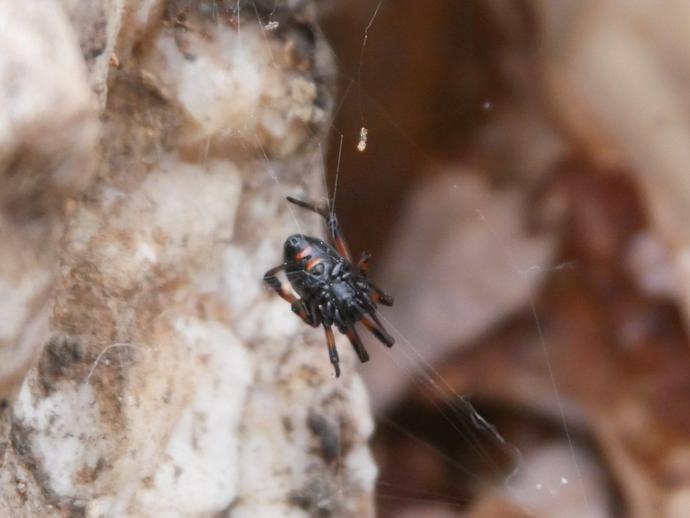
This is Latrodectus mactans, better known as southern black widow
April 14, 2020
This is Latrodectus mactans, better known as southern black widow. According to VMNH Associate Curator of Entomology Dr. Kal Ivanov, the red bands on the legs suggest this one is an immature female; when she reaches maturity, the legs will be solid black. When most people hear the name "black widow spider," it conjures up an image of a massive spider with inch-long fangs dripping with deadly venom, positioned directly beneath a handlebar mustache and top hat (which are obviously the universally-recognized indicators of evil). While getting bitten by a southern black widow isn't a pleasant experience by any stretch of the imagination, it also isn't a death sentence. According to a scientific article from the "Annals of ...
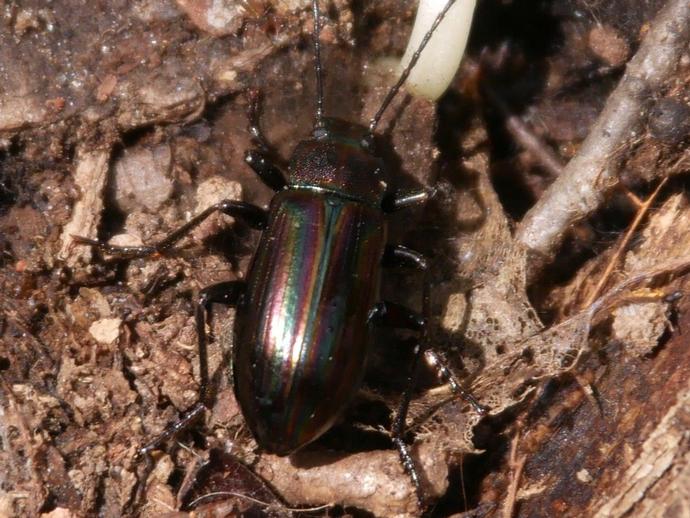
This colorful little guy is Tarpela micans ...
April 13, 2020
This colorful little guy is Tarpela micans, a darkling beetle belonging to the family Tenebrionidae. According to VMNH Research Associate and Professional Beetle Enthusiast Curt Harden (who also identified this fellow for me), Tarpela micans feeds on lichen. The first thing that strikes you about this beetle, of course, is its metallic-looking rainbow-colored elytra (that's the hard shell that covers a beetle's flight wings). As is the case with many insects, these colors aren't solely created by pigments, but rather by complex, tiny structures on the beetle's exoskeleton that reflect light in unusual ways. After doing a little reading on this topic, it quickly became clear that I would need to take a Ph.D.-level course in ...
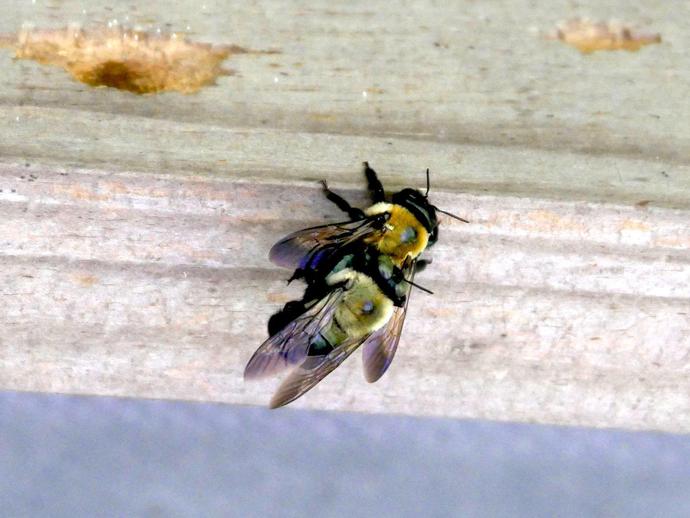
Here we see two eastern carpenter bees (Xylocopa virginica), photographed in flagrante delicto
April 12, 2020
Here we see two eastern carpenter bees (Xylocopa virginica), photographed in flagrante delicto. If you've ever wondered how to tell the difference between a carpenter bee and a bumble bee, it's actually pretty easy: Carpenter bees have shiny black abdomens, while bumble bee abdomens are covered in fuzz. Carpenter bees build their nests in wood, and they especially prefer milled pine and cedar lumber. The nests are either solitary or social, with either one female or several females nesting together. Carpenter bees have a loose social structure; if several females are nesting together, there will be a dominant female that is charge of laying eggs and providing food for the larvae, followed by secondary females that maintain ...
Inspired by the videos produced by my talented colleagues at VMNH ...
April 11, 2020
Inspired by the videos produced by my talented colleagues at VMNH, I decided to create my first nature update video! This video is about Sanguinaria canadensis, better known as bloodroot. I hope you enjoy it! #BenInNature
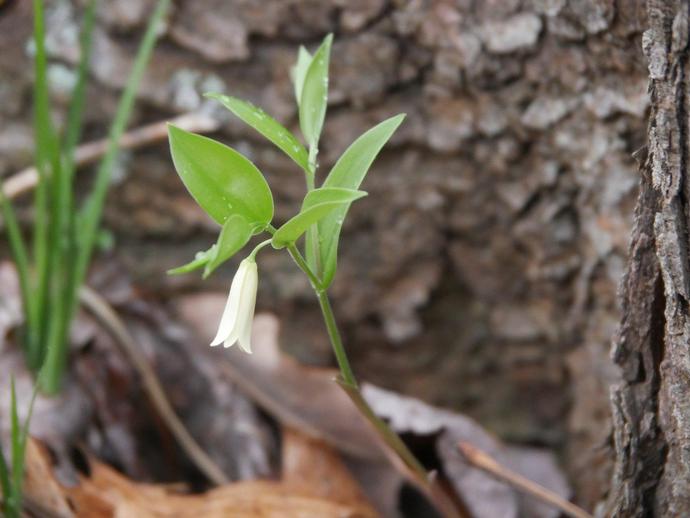
This is Uvularia sessilifolia, also known as the sessile bellwort or "wild oats
April 10, 2020
This is Uvularia sessilifolia, also known as the sessile bellwort or "wild oats." I've been finding a ton of these in the woods just recently, and they're pretty interesting little wildflowers. The Latin name "Uvularia" means "little grape," which likely refers to the way the flowers of plants in this genus hang down and point to the earth. That's also how the uvula, that little fleshy thing that hangs off the soft palate at the back of the throat, got its name! Uvularia sessilifolia are closely related to the lily family, and they can be found in deciduous forests throughout the eastern and central U.S., particularly on slopes and in ravines. While this plant does produce flowers, the flowers often do not result in seeds. ...
Dr
April 9, 2020
Dr. Adam Pritchard, assistant curator of paleontology, may be hunkered down at home for the time being, but he's still determined to bring the wonders and knowledge of paleontology to VMNH audiences! In this episode of "Tales of Ancient Life", Dr. Pritchard is fielding paleo-themed questions that he received from a 3rd grade class from Flintstone Elementary School in Flintstone, Maryland. Dr. Pritchard answers questions ranging from "What is a fossil?" to "What is Dr. Pritchard's favorite dinosaur?" #TalesofAncientLife
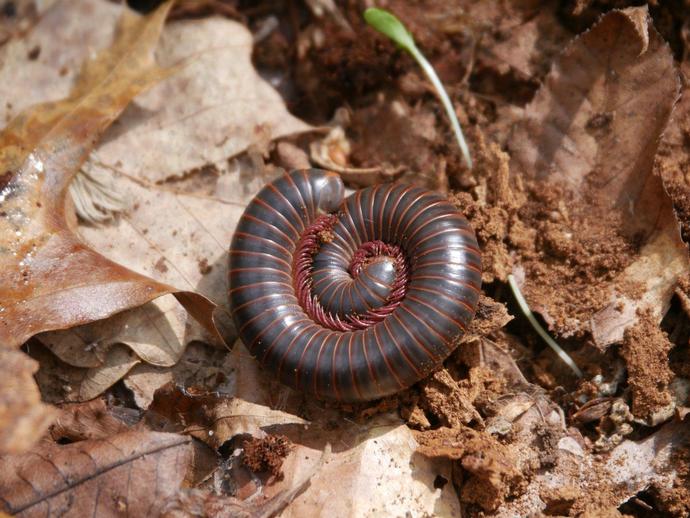
Narceus americanus ...
April 9, 2020
Narceus americanus, also known as the American giant millipede or "iron worm," is the biggest millipede you're liable to find on the east coast. These guys can grow up to four inches long! In a previous post, we talked about how many millipedes can release hydrogen cyanide as a chemical defense when they feel threatened. Narceus americanus doesn't release cyanide, but it can release benzoquinones, which are irritating chemicals that smell a bit like chlorine or bleach. You have nothing to fear from the iron worm, however, and it provides a beneficial service. Millipedes eat vast amounts of decaying leaves and help break down leaf litter into nutrient-rich soil. Narceus americanus, being both large and relatively common, ...
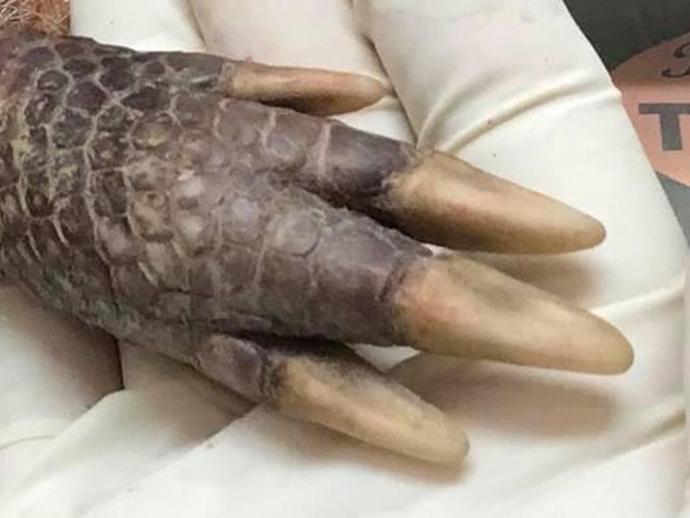
First Officially Documented Armadillo in Virginia Before all museum staff began teleworking ...
April 8, 2020
First Officially Documented Armadillo in Virginia Before all museum staff began teleworking, museum researchers spent recent weeks completing important projects at the museum. VMNH Curator of Mammalogy Dr. Nancy Moncrief and Research Technician Liberty Hightower were busy preparing the first officially documented armadillo found in Virginia (Russell County). This Nine-banded armadillo (Dasypus novemcinctus) specimen serves as the first absolute record of armadillos in Virginia and will be permanently housed in the VMNH research collections. "Armadillos have been recorded in Kentucky and North Carolina and there have been scattered reports of armadillos in the far western counties of Virginia," said Dr. Moncrief. "We ...
From the bones in our bodies to expansive coral reefs ...
April 8, 2020
From the bones in our bodies to expansive coral reefs, "biominerals" grown by living organisms are critical to life as we know it. Join Smithsonian geologist Gabriela Farfan to learn about the minerals around us; what makes "biominerals" so special; and what factors impact their growth. Gabriela will answer student questions, in English and Spanish, about coral skeletons, her career in geology, and her love for minerals. About this program: Our friends at the Smithsonian produce a tremendous series of educational videos called "Science How" video webinars. These live, interactive, free programs explore different science concepts through the lens of Smithsonian scientists. Click to learn more!
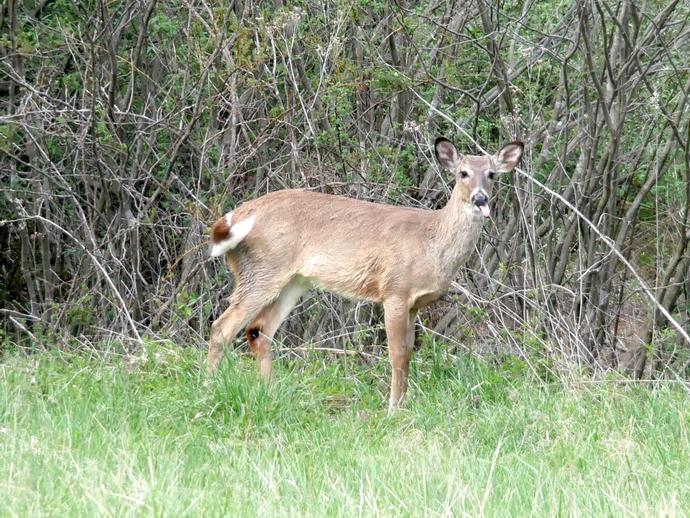
The white-tailed deer (Odocoileus virginianus) is truly a majestic animal ...
April 8, 2020
The white-tailed deer (Odocoileus virginianus) is truly a majestic animal, unless you manage to snap a photo of one sticking its tongue out. White-tailed deer can be found just about anywhere east of the Rocky Mountains in the U.S.; west of the Rockies, they are replaced by mule deer and black-tailed deer. They can also be found as far south as Bolivia and Peru in South America, and they have been introduced in Cuba, New Zealand, several European countries, and a slew of other places. In southwest Virginia, seeing a white-tailed deer is about as common as seeing a sunrise. A hundred years ago, however, white-tailed deer were pretty scarce in much of the U.S., as they were victims of unregulated hunting and commercial ...
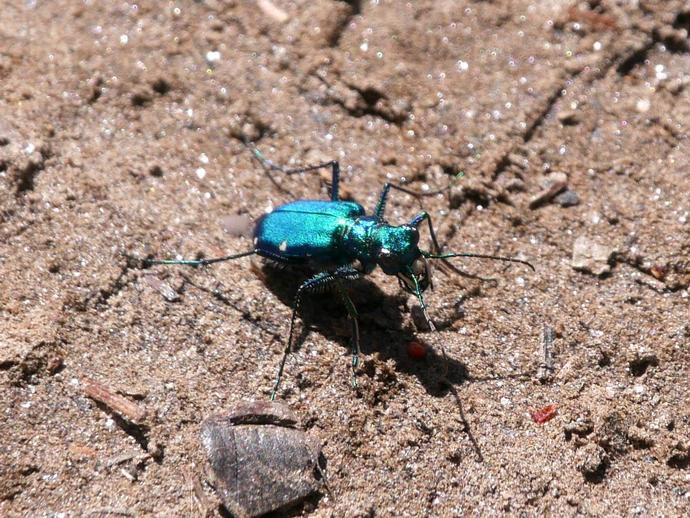
The six-spotted tiger beetle (Cicindela sexguttata) may be small ...
April 7, 2020
The six-spotted tiger beetle (Cicindela sexguttata) may be small, but it's definitely one of the more striking insects you're likely to come across. These beetles are often found in open sunlit areas near or within deciduous forests; I've seen a whole bunch on my gravel road. They move very quickly, and if they're being pursued by a predator they can take flight, although they usually don't fly more than 20 or 30 feet (which is a pretty good distance when you're half an inch long). Most of the time, however, six-spotted tiger beetles are the predators in the equation; those large mandibles aren't just for show. They hunt spiders, ants, caterpillars, and other insects, and if you manhandle one, it might even bite you. ...
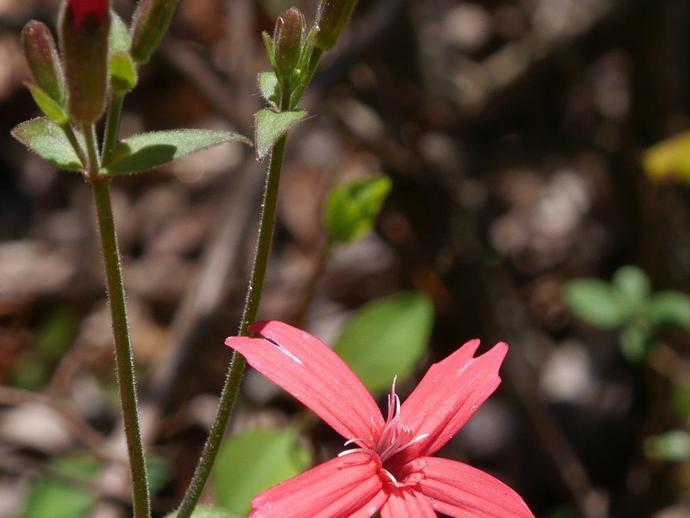
Behold the fire pink (Silene virginica)!
April 6, 2020
Behold the fire pink (Silene virginica)! When I was a little kid, the fire pink was always my favorite wildflower, and my grandma and I would go poking around the old spring every ... spring ... to look for them. Unfortunately, fire pinks are fairly short-lived perennials, lasting only about 2-3 years. I found this one not too far from the old spring, and while it's the first I've encountered so far this year, it will hopefully not be the last. Fire pinks begin blooming in the spring and continue blooming throughout the summer. Their main pollinator is the ruby-throated hummingbird (Archilochus colubris), which is drawn to the bright red flowers and the sugary nectar contained within. Fire pinks belong to the family ...
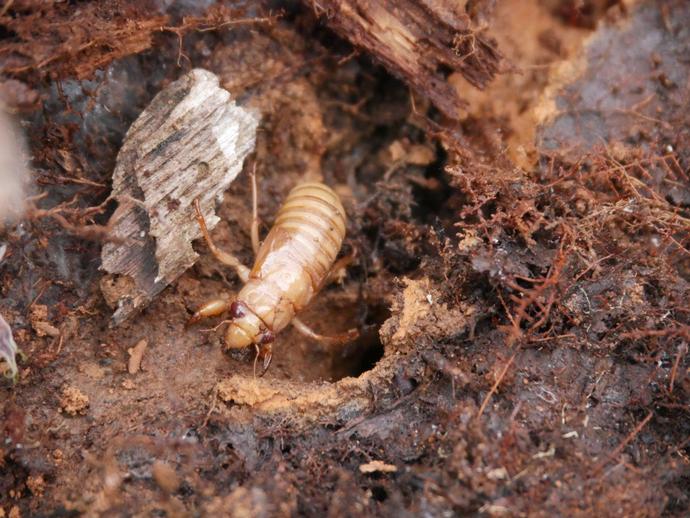
We've all seen (and certainly heard) adult cicadas ...
April 5, 2020
We've all seen (and certainly heard) adult cicadas, and we routinely see their empty shells on trees, but unless you do a lot of digging in the garden, you're not quite as likely to encounter a cicada nymph. Broadly speaking, we have two different flavors of cicada here in southwest Virginia: Periodic cicadas, which emerge in massive broods every 13 to 17 years, and annual cicadas, which appear in smaller numbers every year. Even annual cicadas are not always truly "annual," though; the annual species live underground as nymphs for anywhere from one to nine years, but they emerge at a staggered rate, which is why you hear cicadas every summer. It's believed that periodic cicadas emerge in such massive numbers at such odd ...
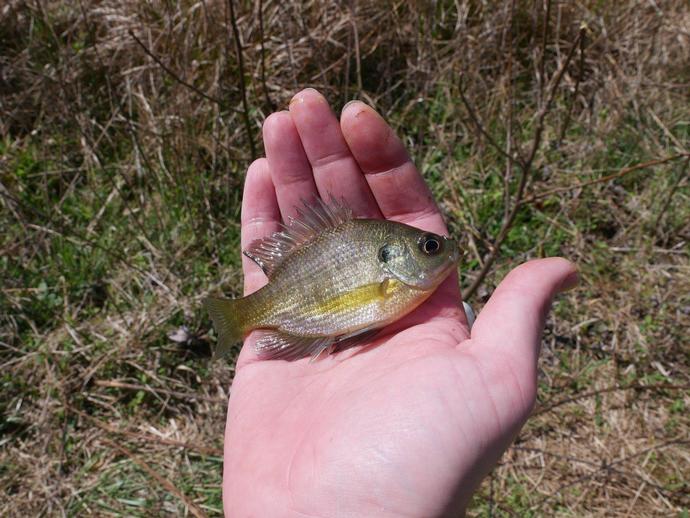
For the final day of Aquatic Week ...
April 4, 2020
For the final day of Aquatic Week, please enjoy this bluegill (which, just in case you were worried, was caught humanely with a barbless hook and then quickly released back into the pond from whence it came). A bit of backstory: In the early 1990s, my grandfather dug out a pond on the old family property. Every time he went fishing, he would take a few fish out of the livewell and toss them in the pond, mostly bluegill and catfish. I don't know that any catfish are still in the pond, but nearly 30 years later, there's still a healthy population of bluegill. Bluegill (Lepomis machrochirus) are members of the sunfish family Centrarchidae. They are native to North America and can be found in any number of streams, rivers, ...
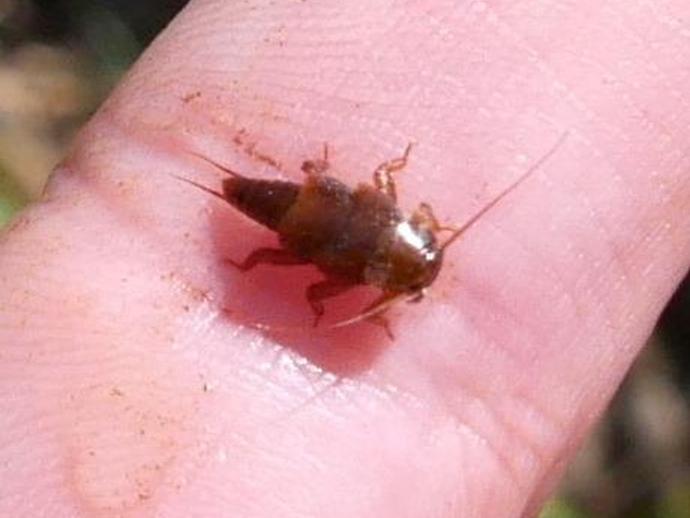
It's day six of Aquatic Week! At first glance, this little guy might look like a cockroach
April 3, 2020
It's day six of Aquatic Week! At first glance, this little guy might look like a cockroach. According to VMNH Associate Curator of Invertebrate Zoology Dr. Kal Ivanov, this is actually a stonefly from the family Peltoperlidae, which are known as the "roach-like stoneflies." Dr. Ivanov said this one is probably Tallaperla maria, the common roachfly. Despite that horrifying name, this fellow isn't closely related to cockroaches, it just bears a superficial resemblance. Stoneflies fall under the insect order Plecoptera, which contains some 3,500-plus species. Stoneflies are one of the most primitive groups of winged insects, and their close relatives have been found in Carboniferous and Permian fossil deposits. This particular ...
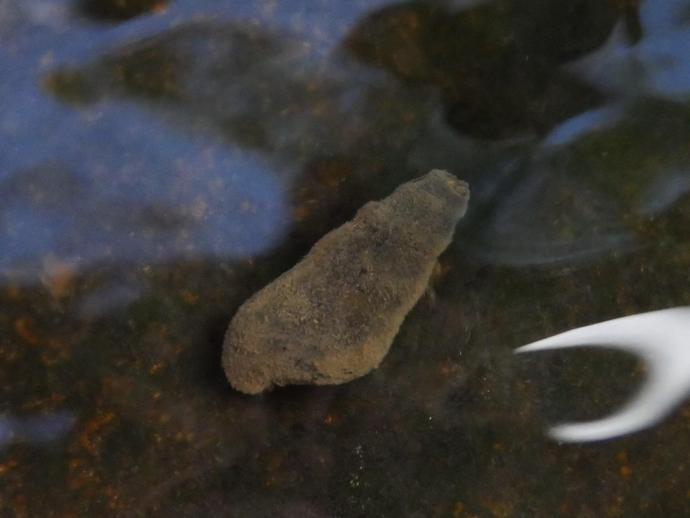
It's day five of Aquatic Week!
April 2, 2020
It's day five of Aquatic Week! Of all the critters I've photographed for this week's updates, these little guys were probably the most cooperative. These small aquatic snails are almost certainly from the family Pleuroceridae, which are only found in Eastern North America. Most snails in this family live in streams and rivers, although a handful of species are adapted to living in lakes and reservoirs. These snails have what's known as an "operculum," which is sort of like a trapdoor that allows the snail to completely seal itself up within its shell to deter predators. The operculum is connected to the snail's foot and is pulled closed when the snail retreats into its shell. They scrape algae off of rocks using their radula, ...
Dr
April 1, 2020
Dr. Adam Pritchard, assistant curator of paleontology, may be hunkered down at home for the time being, but he's still determined to bring the wonders and knowledge of paleontology to VMNH audiences! "Tales of Ancient Life" is a series of videos in which Dr. Pritchard will be exploring fossils from the VMNH collections, how they fit into our world, and the whole of the history of the fossil record. #TalesofAncientLife
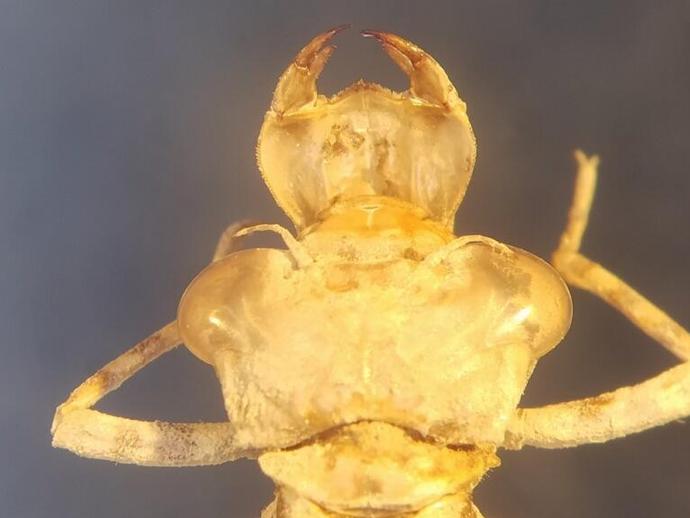
While all museum staff are preparing to transition to telework by the end of the week ...
April 1, 2020
While all museum staff are preparing to transition to telework by the end of the week, work in the museum's bug lab continues today with the identification of dragonfly nymphs; immature stages also known as naiads. Identification can be challenging and requires examination of minute characters under high magnification. Dragonfly nymphs are aquatic and are voracious predators, eating most living things that are smaller than themselves. Diet includes blood worms and insect larvae, but some larger nymphs can capture and eat tadpoles and even small fish. Prey are detected visually and, when prey moves within reach, the nymph rapidly extends its prehensile labial mask and thrusts it forward, grabbing its prey. Some nymphs, such ...
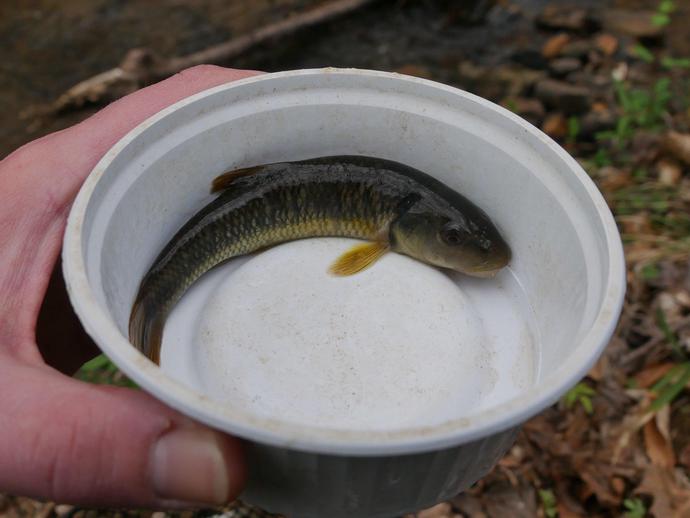
It's day four of Aquatic Week!
April 1, 2020
It's day four of Aquatic Week! In the spirit of April Fools' Day, I considered doing today's update on the Loch Ness Monster or something, but I ultimately decided that I didn't need to add more misinformation to Facebook. There's probably more than enough on there. Instead, please enjoy this fish! According to Kyle Snow, a fish expert from James Madison University, this is probably a bull chub (any uncertainty is the result of my photography, not his expertise). I caught this one in a small creek using a minnow trap. When we think of the types of fish that can commonly be found in creeks and streams, we generally think of tiny minnows. However, there are some pretty sizeable members of the minnow family (Cyprinidae) and the ...
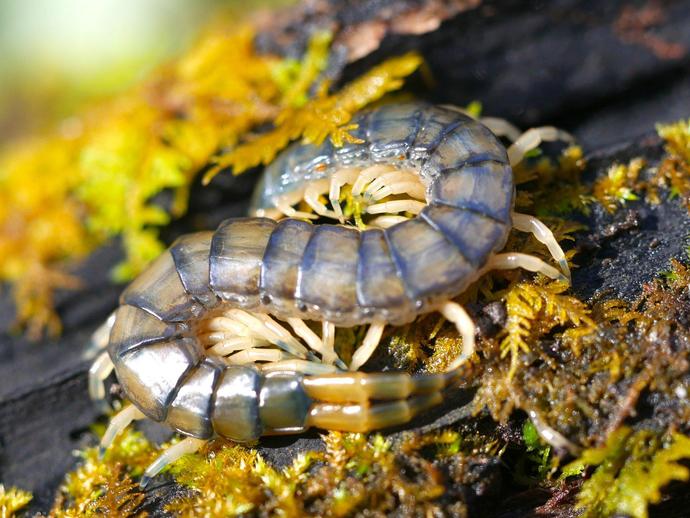
Big shout-out to the museum's Research & Collections team for rising to the occasion and ...
April 1, 2020
Big shout-out to the museum's Research & Collections team for rising to the occasion and donating 410 N95 masks and 1,900 pairs of protective gloves to SOVAH Health - Martinsville! R&C staff uses this type of personal protective equipment for some of its day-to-day activities, but a much greater need currently exists.
Archives
2026
2025
2024
2023
2022
2021
2020
2019
2018
2017
2016
2015
2014
2013
2012
2011
2010
2009
2008

Please Visit Us Soon
Hours:
Tuesday - Saturday: 10am - 4pm
Sunday: Noon to 4pm (Memorial Day Weekend through Labor Day Weekend only)
Monday: Closed
Admission:
$12 for ages 18-59
$6 for ages 3-17, seniors 60+, and college students
FREE for children under 3, museum members, members of ASTC Passport participating institutions, and EBT cardholders
My 4 year old son loves going to the museum. The exhibits are educational, interactive and kid-friendly.
”

 Hours & Admissions
Hours & Admissions Directions
Directions